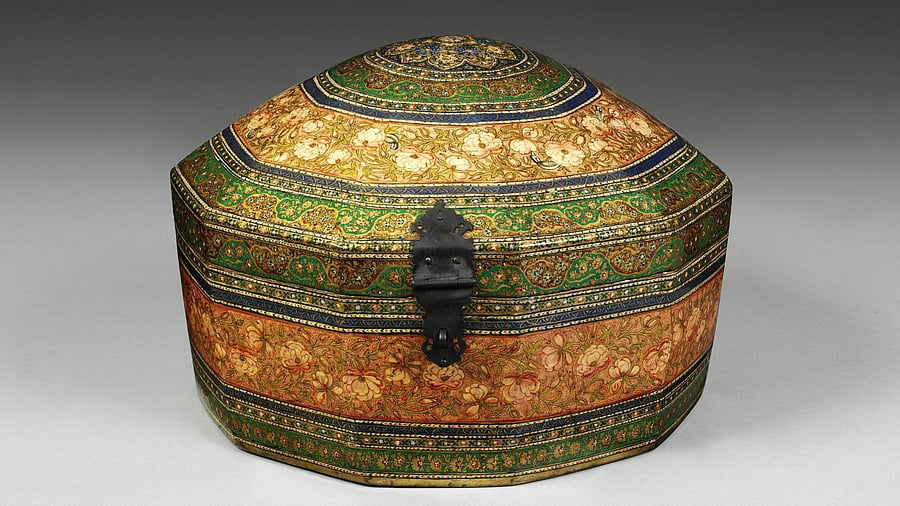
Papier-mache box, Kashmiri (1850)
Credit: V&A, London)
Legend has it that when the mystic Mir Sayyid Ali Hamdani made the long journey from Iran to Kashmir in the 14th century, he brought along 700 craftspeople who introduced local artisans to exquisite Persian traditions and techniques. One of these was papier-mache, meaning ‘mashed paper’.
While the art of painting on items made from wood and bark had already been perfected in Kashmir, the introduction of papier-mache allowed this skill to be applied to a new medium. Kashmiri papier-mache typically features stylised, intricate floral patterns, motifs such as the badam and buta, Persian poetry, Quranic verses as well as forest and Mughal court scenes. It is used to adorn a range of products, from vanity boxes to the delicate interiors of mosques such as the Khanqah-e-Moula in Srinagar.
Passed down orally from generations, creating Kashmiri papier-mache involves sakthsazi, or mould-making, traditionally done by Sunni Muslim craftspeople and naqqashi, or painting, usually done by Shia Muslim craftspeople. First, the sakhtasaz prepares the pulp in a giant pot by soaking paper strips in water, after which it is beaten with a wooden pestle and mixed with a local adhesive solvent. The pulp is then coated onto a base mould and laid out to dry in the sun. Next, the base mould is removed while the coat is still slightly wet, by cutting along the centre with a saw. Lacquer is then applied to the surface, and it is then smoothened with pumice stone or burnt brick.
Once the base is ready, the naqqash prepares the design on a layer of pasted butter paper. The designs are rendered freehand using brushes made from the hair of Pashmina goats and pencils made from cat fur. While the areas to be painted in darker colours are first coated in white and then coated with the desired colour, the lighter colours are directly painted onto the base, and the whole design is often outlined with gold. The object is finished with a layer of varnish that is applied on top to seal the paint and provide lustre.
Numerous families have produced master artisans who have gained national and international recognition for their contributions to the craft. Maqbool Jan, for example, has won several prestigious awards, including the 2008 UNESCO Seal of Excellence Award, and Fayaz Ahmed Jan, one of India’s foremost papier-mache artisans, was awarded the Padma Shri in 2019.
However, given the political unrest, the pandemic, dwindling tourism and devastating natural disasters, the Kashmiri papier-mache tradition is facing considerable challenges in sustaining itself. Meagre wages for such a laborious art have only compounded problems. Despite these hardships, some young Kashmiris are still eagerly learning the craft, hoping to preserve an ancient tradition which is intimately associated with the culture and history of the Valley.
Discover Indian Art is a monthly column that delves into fascinating stories on art from across the sub-continent, curated by the editors of the MAP Academy. Find them on Instagram as @map_academy